ePostcard #117: Nightwatch: From Sand to Sea (Part 3)
Cover Photo (above) Credit and Caption: Courtesy of Florida Fish & Wildlife. A “boil” of green sea turtle hatchlings emerges en masse from their deep nest hole in the sand. At hatching time, usually as the sun sets and the warm sand begins to cool, turtle hatchlings begin the arduous process of digging themselves out of their nest, a process that can take several days. In the absence of predators or the distraction of artificial light pollution, the hatchlings will instinctually look for any bit of natural light reflecting off the water and head towards the shoreline. This beautiful photo captures that magical moment for green sea turtle hatchlings as they find their way down to the sea.
A New Year’s Message: Having finally crossed the threshold of 2021, I admit to having been beset for weeks by the challenges of navigating—with meaningful words—the tumultuous seas, both political and environmental, of our changing world. Some might call it writer’s block, but for me the struggle has been to offer my readers a balanced visual and narrative celebration of life’s exquisite diversity—a call to action tempered by hope, and not a requiem for all that we have lost. The many tragedies of the COVID pandemic, Trump’s war on science and truth, the cross-societal impacts of embedded racism, the overturning of critical environmental goals and protections and, finally, the drought-driven realities of wildfire in the West, made me question the relevance of my ePostcards in these troubled times. The insurrection of January 6th shifted the ground beneath my feet, my emotions vacillating between a feeling of helplessness and a profound rage at the perpetrators of this senseless attack on democracy and truth. As I reflect on the scope and breadth of the environmental work that must be done in the years to come, I’m even more determined to renew my commitment to inspiring the next generation of environmental stewards and encouraging them to listen to what our ecosystem sentinels are telling us. Join us for our first virtual field trip of 2021!
ePostcard #117: Nightwatch: From Sand to Sea (Part 3)
In a breeding season ritual that has gone on for millions of years, female loggerhead sea turtles come ashore for a few precious hours each year to dig nest chambers in the sand and lay their eggs, often on beaches remarkably close to where they themselves hatched. Loggerheads have a cosmopolitan distribution, nesting over the broadest geographical range of any sea turtle. They inhabit the Atlantic, Indian, and Pacific Oceans and the Mediterranean Sea. The Northwest Atlantic Ocean’s loggerhead nesting population is considered to be the largest in the world, and Florida hosts approximately 90 percent of the nests associated with this population.
We have joined a group of Conservancy of Southwest Florida volunteers and are sitting on a secluded beach on Keewaydin Island, one of southwest Florida’s largest unbridged barrier islands. Keewaydin is part of the Rookery Bay Research Reserve, which also includes one of the largest and most pristine subtropical mangrove estuaries in the world. The Conservancy’s biologists and citizen volunteers have been monitoring sea turtle nesting and hatchling recruitment on Keewaydin Island continuously since 1982, making it one of the longest running sea turtle monitoring/research programs in the nation. Since the turtle monitoring program’s inception, the Conservancy has documented over 284,000 hatchlings from Keewaydin Island reaching Gulf of Mexico waters. It is important to remember that only 1 in 1,000 hatchlings are thought to survive to adulthood, so each egg plays a crucial role in recovery efforts for this species.
It is early in the sea turtle breeding season and we are watching as a female loggerhead drifts towards shore on an incoming wave. As she gets closer, we can now see her large head and imagine that she is scanning the beach for potential danger. Using her winglike fore flippers, she propels herself through the surf, landing on the wave-washed beach like an oar-powered dory from a bygone era. She remains motionless for a few moments, with her eyes closed and her flippers splayed out, and I realize that I’m holding my breath in anticipation. In the water she was a graceful and buoyant voyager, but we now watch as she gathers her strength and takes in great gulp of air to make the transition from sea to land.
Jostled by a wave, she uses its lift to coordinate her flippers and begins the laborious climb up the gently sloping beach. The deeply entrenched, tractor-like trail that this 350-pound loggerhead leaves in her wake is a testament to her maternal determination. She is very focused, seemingly oblivious to our presence, passing quite close as she searches for the right spot to dig her nest chamber and lay her 20+ eggs—a “sense of place” archived in her brain. I can see that her shell is its own marine ecosystem, with patches of green algae and barnacles along for the ride. We don’t move, speak and or do anything to distract her. We’ve been shown examples of “false crawls,” where females have aborted their search due to an encounter with a potential predator or disruptive human activities.
Finally, well above the high tideline, in dry sand, she stops and turns slowly to face the sea, rotating her massive body with her flippers to excavate a deep depression in the sand. With the turtle-powdered sand storm she creates as she digs, the researcher must move closer to scan her fore flippers for a metal identification tag, which would indicate whether she’d visited this or another monitored nesting beach in the past. There is no visible tag on either flipper. Using her smaller hind flippers “cupped” like a shovel, she expertly deepens the nest vertically to receive the eggs. Positioning her tail directly over the hole, we can hear her soft whooshing exhalation and the muted sounds of several soft-shelled eggs dropping into the nest chamber. She pauses between each bout of egg laying and we see a viscous fluid flowing out to coat each successive batch, which serves to keep the leathery eggshells moist until she backfills the nest securely with damp sand.
Once the nest is completely backfilled to her satisfaction, the Conservancy researcher beckons us to help him hold her in place while a volunteer measures her shell, takes a tissue sample for DNA, and then attaches a metal tag to her fore flipper that will identify her if she returns to Keewaydin or travels elsewhere in the world. Before we leave the beach, a wire mesh cage is placed over the nest to protect the eggs from predators such as raccoons, foxes and dogs, while still allowing the hatchlings to crawl freely toward the water once they hatch. There is virtually no evidence of post-laying maternal care or that females remain near their nesting beaches to see their hatchlings emerge. The whole nesting process takes just a couple hours, and we can only wish her well as she makes her way back down to the Gulf. As the 38th season of loggerhead nest monitoring on Keewaydin drew to a close in 2020, coincident with widespread COVID-related beach closures, the Conservancy reported that a record-breaking 421 loggerhead nests were laid on the small island.
click images to enlarge
#2. Photo Credit and Caption: Courtesy of Alnitak Marine Research and Education. Loggerhead sea turtles are ocean voyagers and after years at sea attract a miniature ecosystem on their shell, acting like a small oasis for marine life in the vast oceans.
#3. Photo Credit: Courtesy of the Environmental Science staff of the Conservancy of Southwest Florida.
Caption: A female loggerhead turtle arrives at her nesting beach at Keewaydin Island.
#4. Photo Credit: Courtesy of the Environmental Science staff of the Conservancy of Southwest Florida.
Caption: At night and at sunrise, between May 15 to August 15, Conservancy team members use ATVs to scour beaches in order to catalog new nests and cover them with protective wire cages to keep out raccoons and other predators until the eggs hatch. These nest counts serve as a key indicator of the overall population’s health. Female loggerheads tend to lay eggs only every three to four years, so the numbers often fluctuate. Scientists are reporting an increasing number of nests each year, a rebound that can likely be traced to two critical conservation measures implemented decades ago. With the listing of loggerheads as a threatened species in 1978, wildlife biologists and marine conservation organizations joined forces to identify key sea turtle nesting beaches (for all species) and coordinated efforts to monitor and protect turtle nests over the roughly 60-day incubation period from egg laying to hatching. Additionally, since 1987, shrimp boats trawling in U.S. waters have been required to equip their nets with escape hatches for sea turtles.
#5. Photo Credit: Courtesy of the National Park Service (public domain multimedia credited to NPS).
Caption: The tracks of a female loggerhead in the sand near her nesting beach on Keewaydin Island. These comma-like tracks are typical of loggerheads as they alternate their flippers to move in the sand.
#6. Photo Credit and Caption: Courtesy of U.S. Fish and Wildlife Service. By the time a loggerhead comes to shore for the first time, she has spent about 30 years at sea. With her powerful flippers, she excavates an egg chamber in the sand, deposits a clutch of approximately 100 to 120 eggs, and then covers the pit with sand before immediately returning to the sea.
#7. Photo Credit: Courtesy of Thomas Reischig and the Turtle Foundation.
Caption: This loggerhead is laying the last batch of her in eggs in a hole that is estimated to be at least a couple feet deep. On average, loggerheads lay about 100 ping pong ball-sized eggs in each nest, and typically dig at least 2 to 3 nests each breeding season. In most species, gender is determined during fertilization. However, the sex of most turtles, alligators, and crocodiles is determined after fertilization. The temperature of the developing eggs is what decides whether the offspring will be male or female. This is called temperature-dependent sex determination, or TSD. The loggerhead hatchlings, which begin to emerge from their soft shelled egg after an incubation period of about 60 days, will be predominately male if incubation temperatures in the sand are under 85°F or predominately female if temperatures are over 85°F. Heat produced by the developing embryos in their eggs also contributes to the incubation temperature within the nest, with eggs in the center of the nest tending towards females and the eggs around the cooler periphery of the clutch biased towards males. Climate change is clearly affecting sea turtle populations by warming the temperature of the sand that the eggs are laid in, which in turn affects the outcome of the hatchlings’ sex. Some turtle biologists suggest that even a 1 degree C warming of average temperatures could drive a significant sexual bias towards females. If average warming exceeds 3 degrees C in the decades ahead, it is likely that egg/embryo mortality will also increase. More females being born could benefit turtle populations in the short term, since the number of females determines how many eggs can be laid in the next generation. But if TSD continues to favor females, some researchers believe that a temperature-driven bias towards females may eventually mean that there simply won’t be enough males to sustain a population. Sea turtle populations that nest in the southern coastal areas of the United States (Texas, Florida, Georgia and South Carolina) are already predominately female.
#8. Photo Credit and Caption: Courtesy of the Conservancy of Southwest Florida. In 2020, the Conservancy concluded its 38th season of loggerhead sea turtle nest monitoring on Keewaydin Island, in the Gulf of Mexico. This Keewaydin loggerhead is returning to the Gulf after laying her eggs, a rare sighting during daylight hours.
#9. Photo Credit: Courtesy of the Environmental Science staff of the Conservancy of Southwest Florida.
Caption: As sunset washes Keewaydin Island in apricot and lavender, we discover another loggerhead settled atop her nest chamber and laying eggs. You can see another nest site just a short distance away with its wire cage for predator protection.
#10. Photo Credit: Courtesy of Harry Baker and the 4/4/2020 marine madness.blog.
Caption: Note the ephemeral tiny brownish “egg tooth,” or caruncle, situated on the baby turtle’s developing beak, which it will use to poke open the leathery eggshell. As they begin to emerge from the egg they’ll start to straighten out and absorb some of the nutrients in their yolk sac. As soon as the majority of hatchlings have emerged, they appear to work “cooperatively” in digging their way out of the nest . This is a major undertaking for the tiny hatchlings, taking several days, with the only source of energy being the yolk that remains when they hatch. They make their way to the surface in a rough and tumble manner, climbing over and on top of one another and the empty eggshells. As they struggle, they loosen sand avalanches that trickle down between the climbing hatchlings, eventually easing their way to the surface. The cooling of the sand at nightfall is what triggers the hatchlings to rise en masse—an amazing “boil” of hatchlings that erupts at the surface.
#11. Photo Credit: Courtesy of Florida Fish & Wildlife.
Caption: Loggerhead hatchlings beginning the multi-day struggle to emerge from the nest. Note the turtle heads beneath the two already at the rim of the nest.
#12. Video. Fast-forward to hatching time with this remarkable video and witness one of the most amazing phenomenons in the natural world—a “boil” of emerging loggerhead hatchlings!
#13. Photo Credit: Courtesy of the Environmental Science staff of the Conservancy of Southwest Florida.
Caption: This baby loggerhead leads the last group of hatchlings down to the Gulf from their nest on Keewaydin Island.
#14. Photo Credit: Courtesy of the Environmental Science staff of the Conservancy of Southwest Florida.
Caption: With the last hatchlings headed to the sea at the end of the Conservancy’s 38th nest monitoring season on Keewaydin Island, this staff member has removed the anti-predator screen and has excavated the nest to assess nesting success and failures, also determining whether or not the nest was predated, flooded by tides or washed away.
click images to enlarge
To help build global awareness, we would appreciate it if you would share this post with your friends and colleagues. Please choose one of the options below which includes email and print! Thank you.

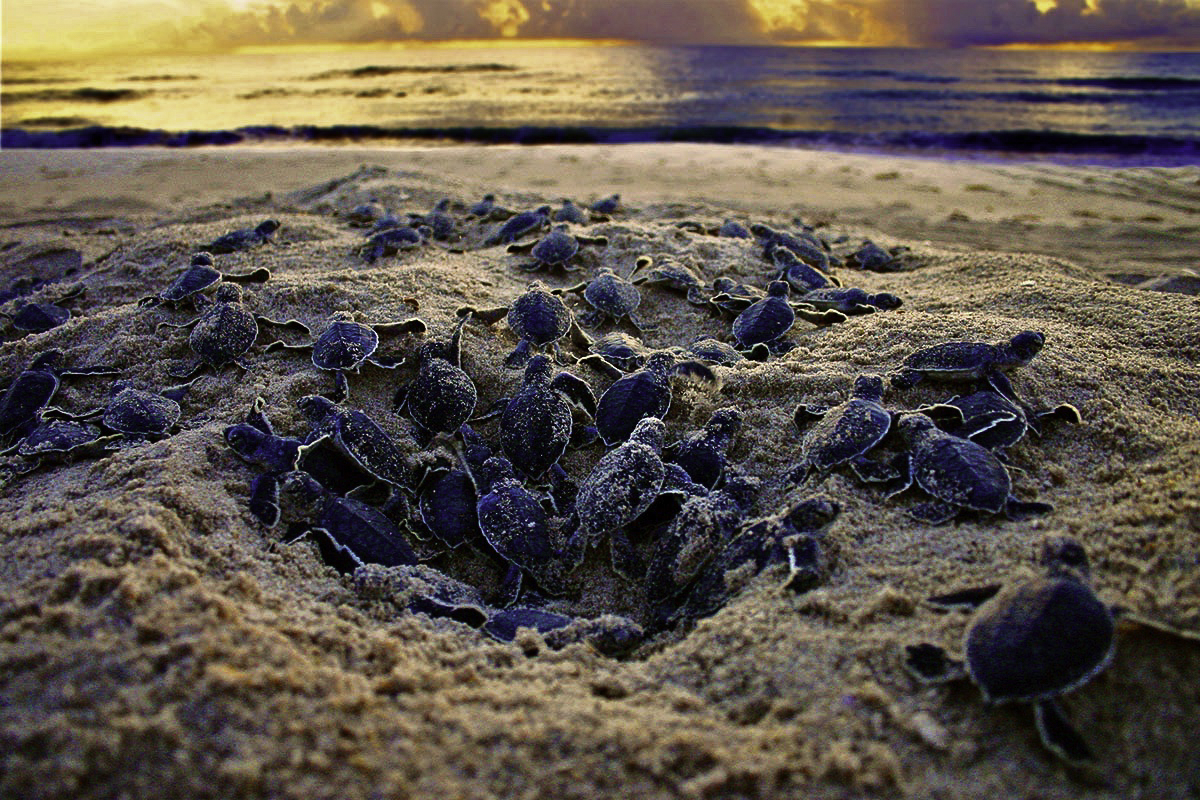
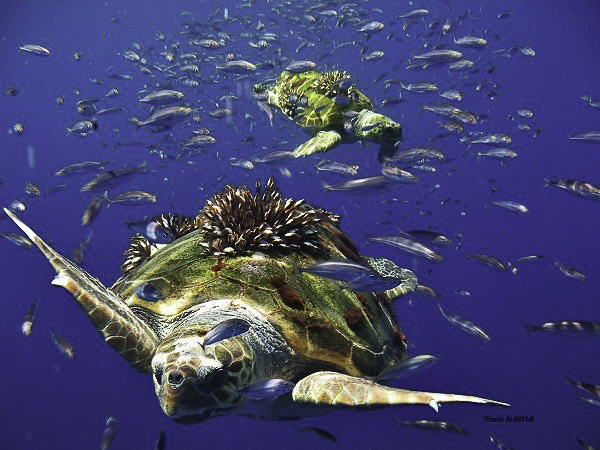
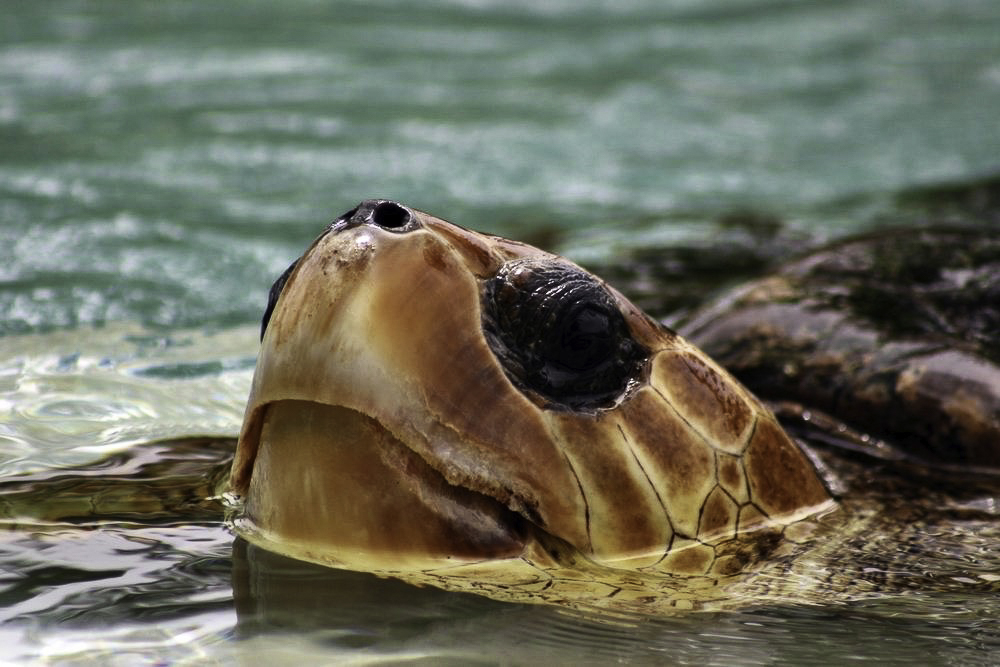
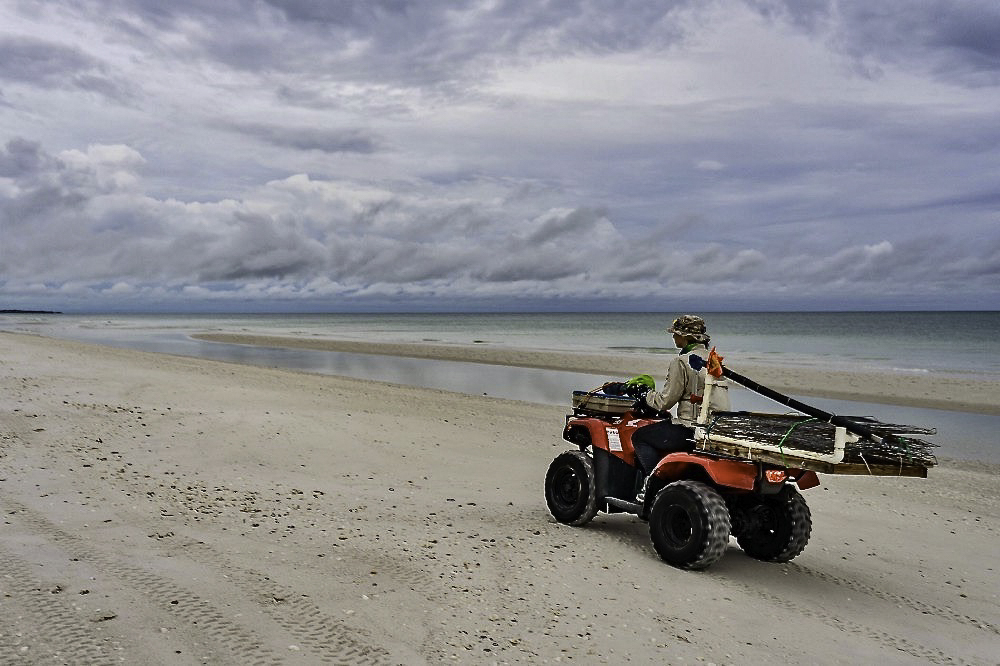
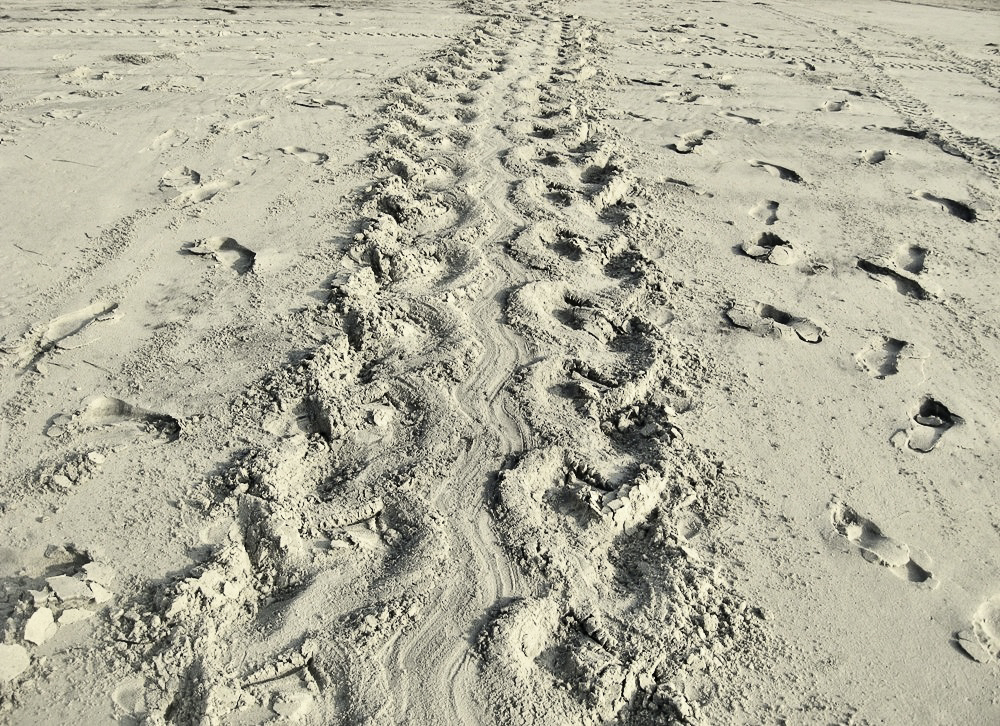
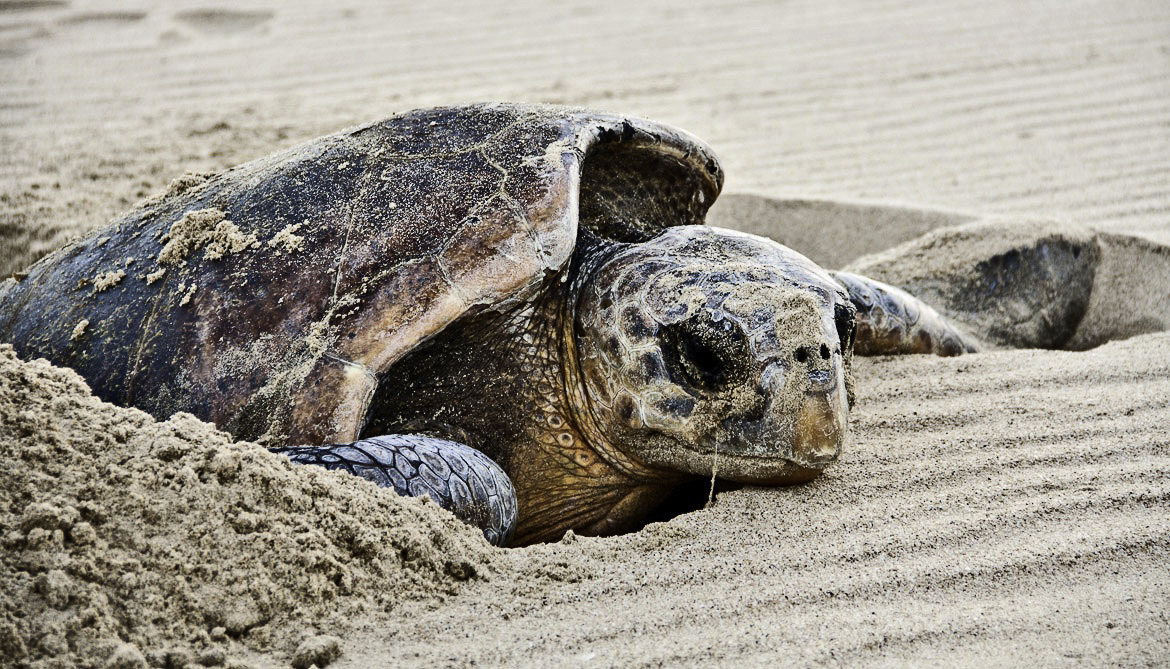
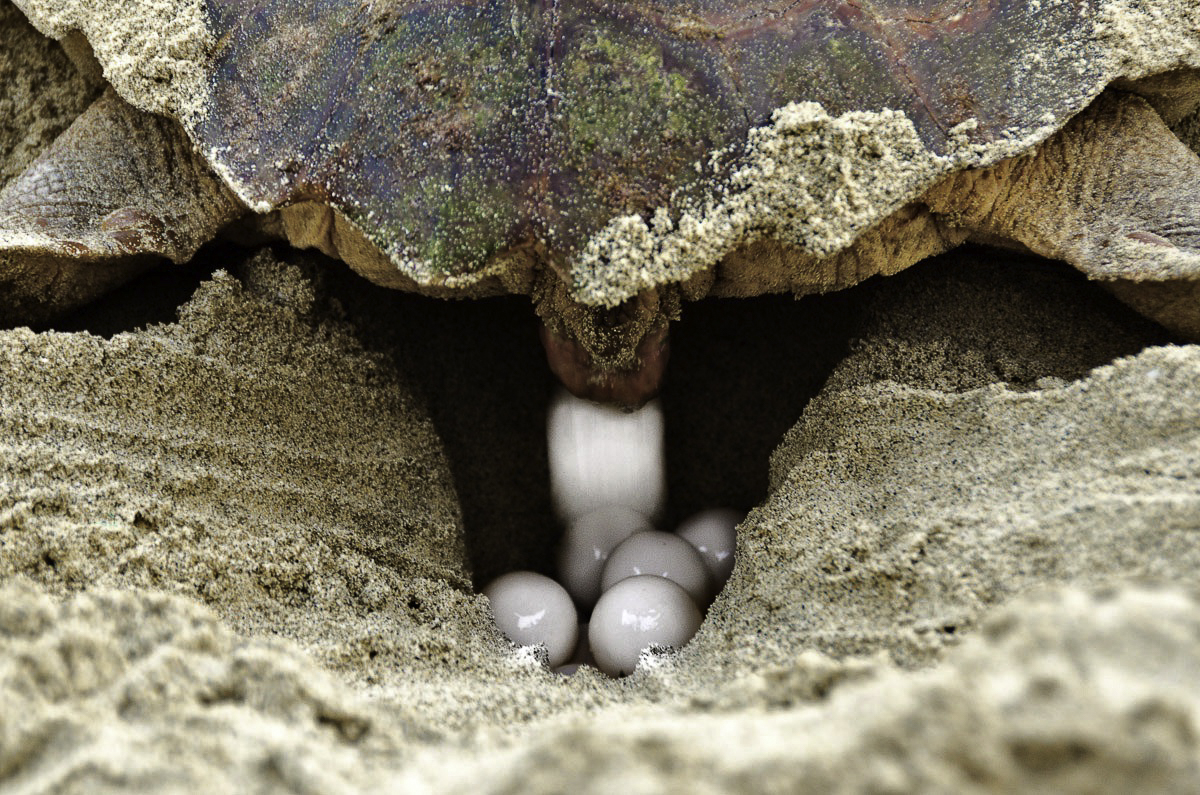

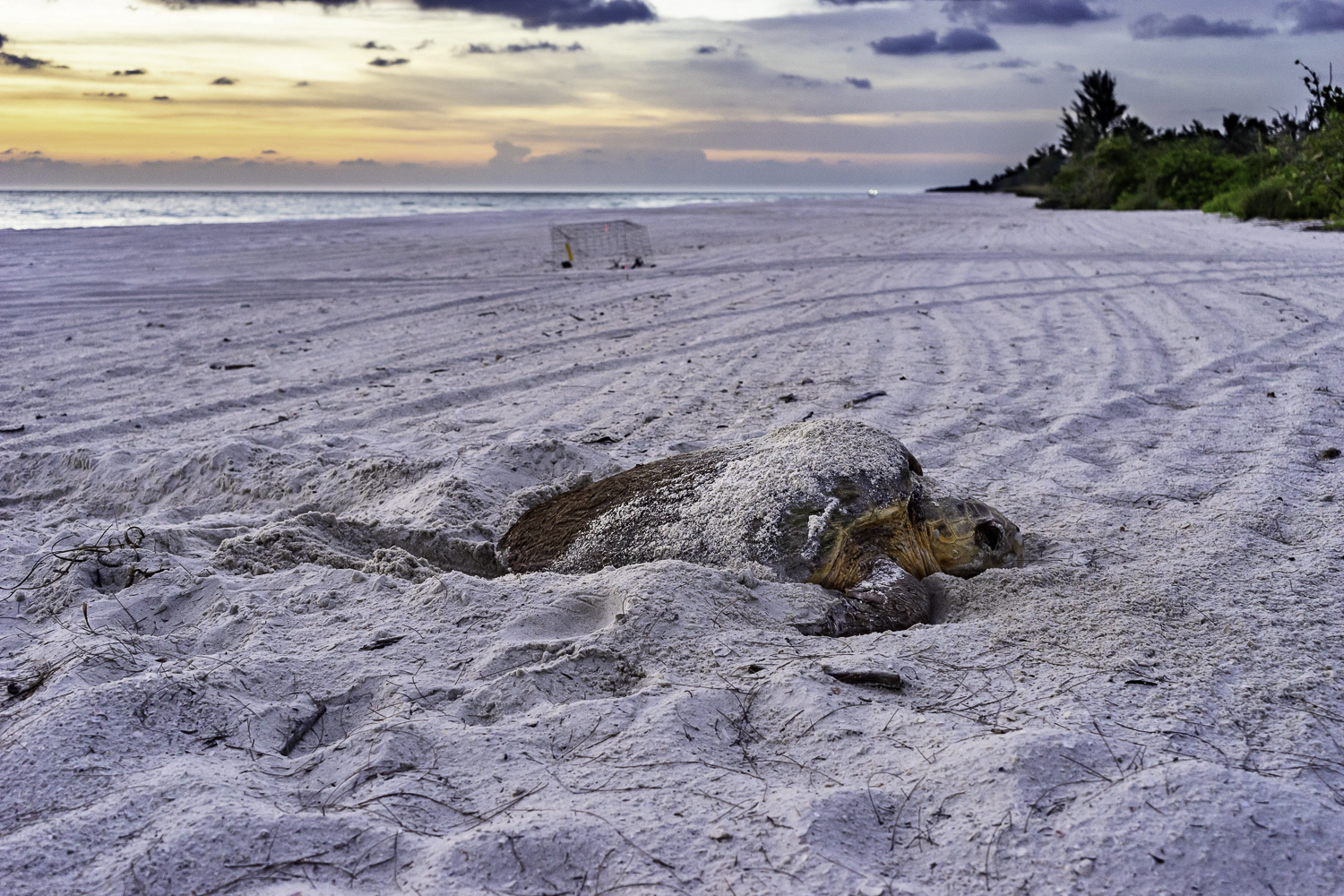
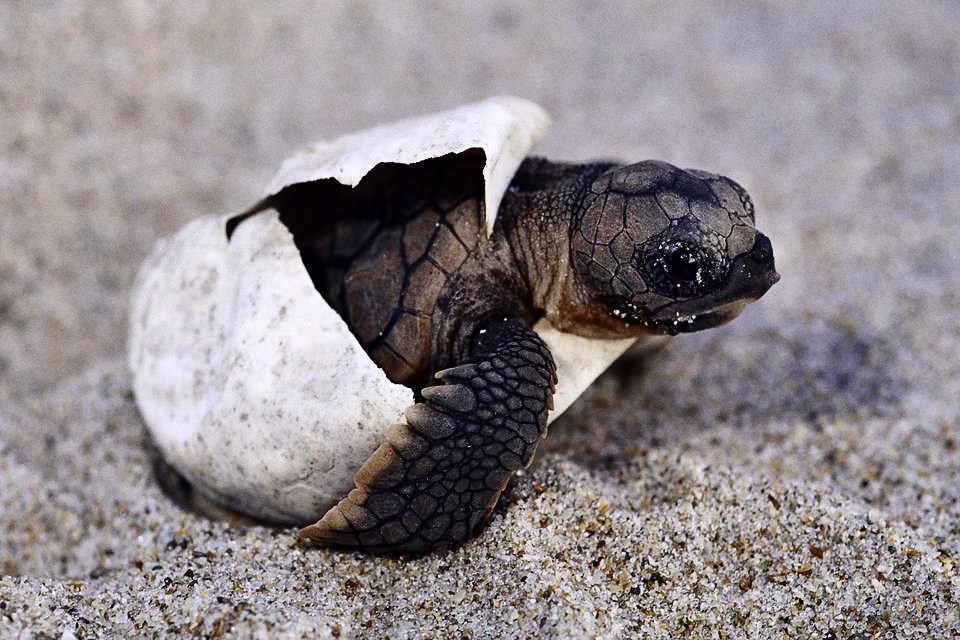
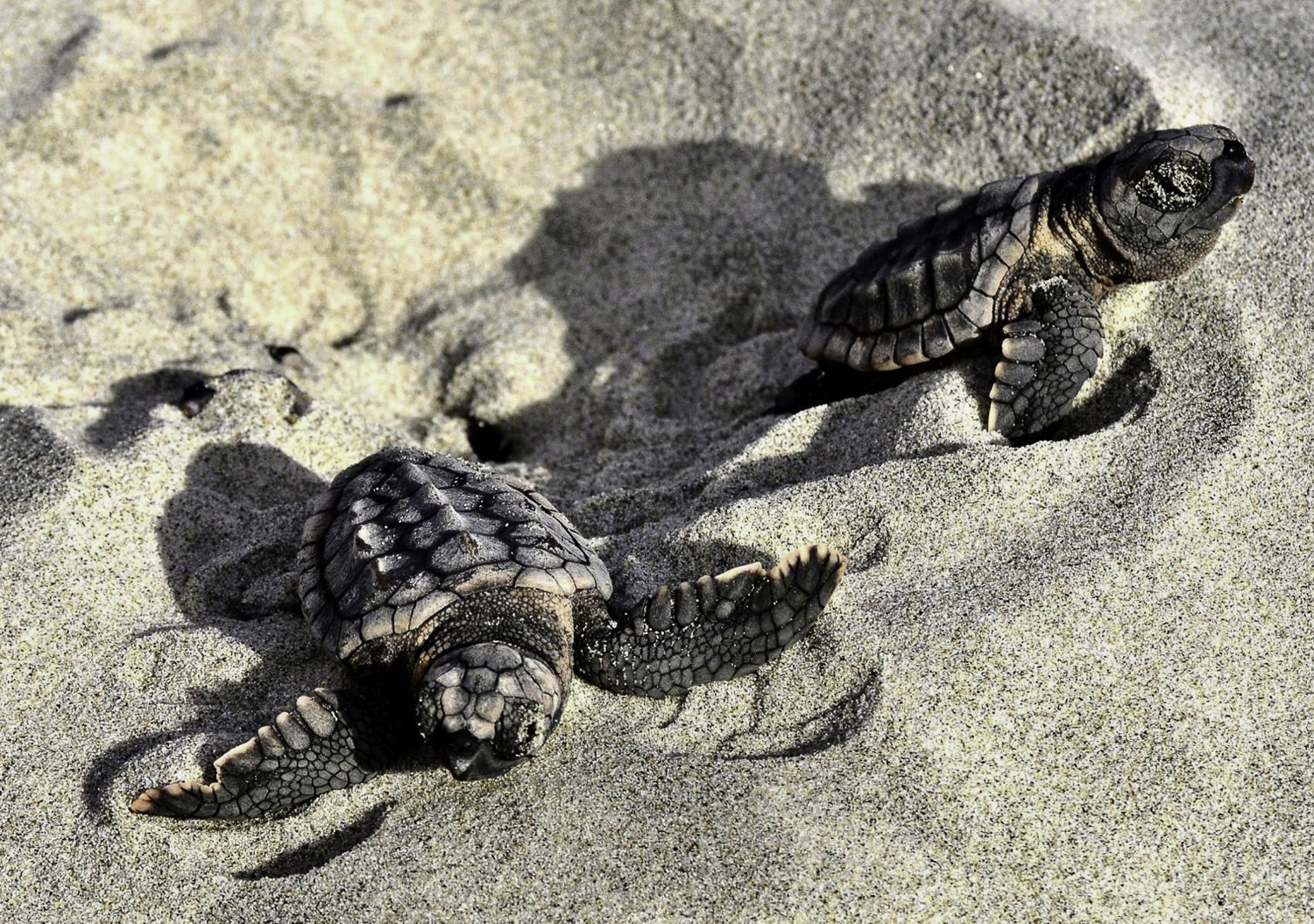
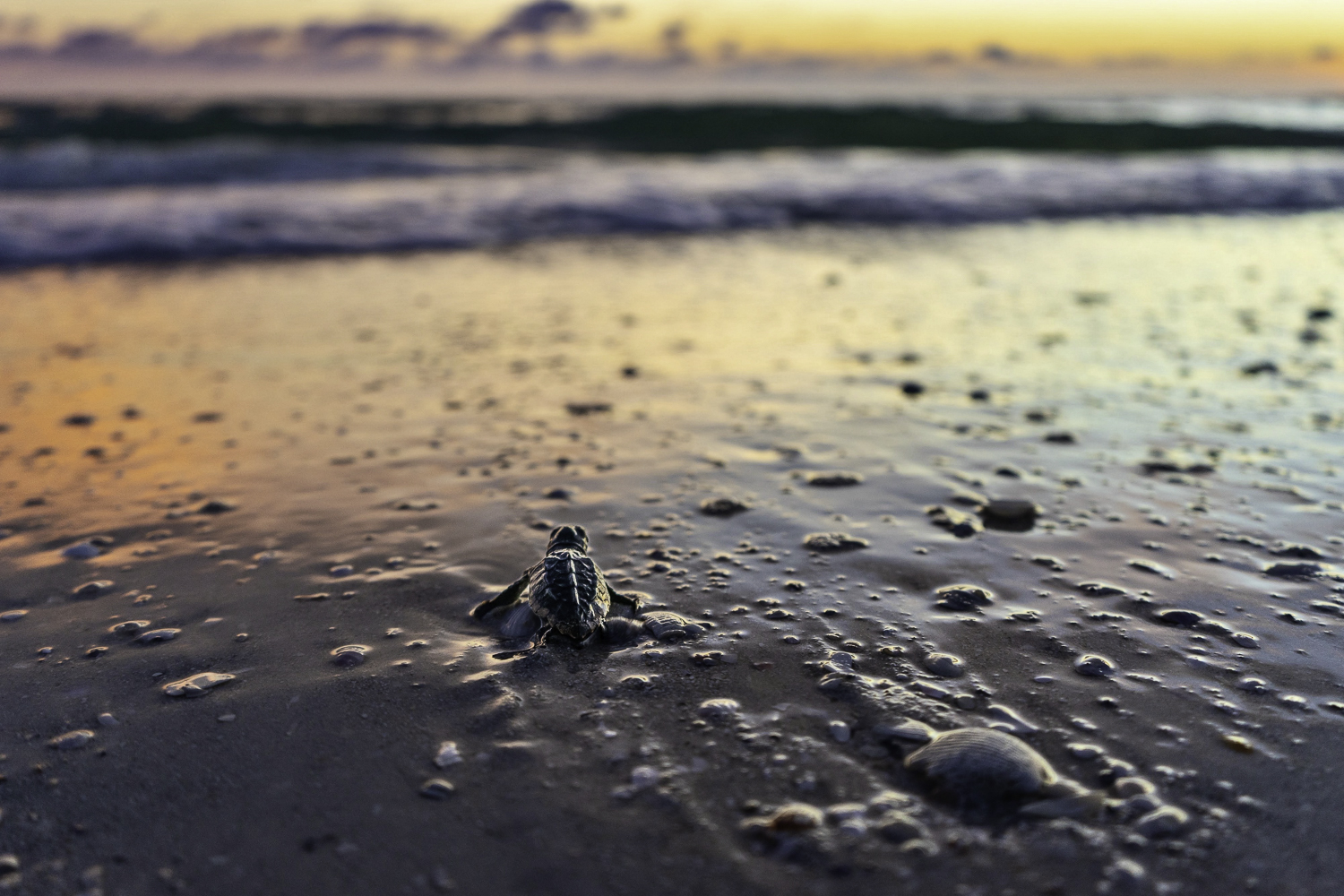
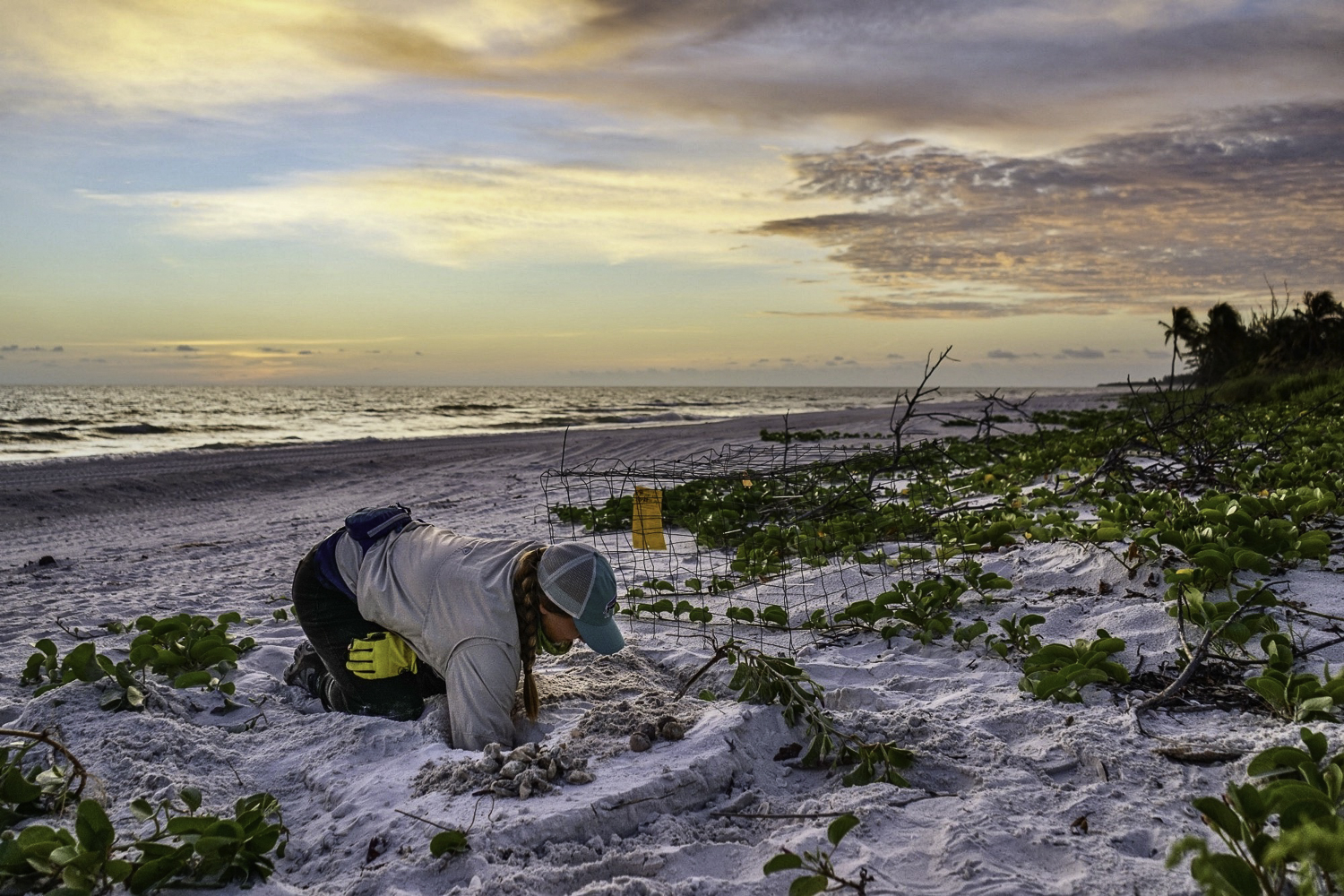
Audrey, that video! What an amazing e-postcard this was today! No wonder you are enthralled with sea turtles.
Ivy says “The babies were so cute and I loved the video!” The “boil” was mesmerizing! Even Hays was glued to the screen watching every last baby climb out. Thank you!
Thank you, Audrey. As we start this year, I can’t escape this (maybe trite) metaphor of a loggerhead arriving at the beach. Pausing to reflect on the long journey to get here, realizing the magnitude of the task ahead in this now alien, hostile environment, summoning strength and determination to do what must be done. The beach is warmer now, more threatening now, with dizzying lights and distractions. But the struggle is the same as it has been for millions of years, and, if we succeed, could be for millions more. Thank you for showing us.
Hi Audrey, I forwarded this e-postcard to my grandson, Jake Miller. He said that students at his previous school where he taught biology and environmental education had participated in such a sea turtle watch. Jake is now getting his masters at CSU in environmental education. He and his brother, Preston with my daughter, Anne went on a Yampa-Green river trip with you several years ago. Passing the torch. Thank you Audrey!
Thank you , thank you , and one thousand thank you’s. These most fascinating images and the video are priceless.
And thank you for your New Year’s heartfelt,realistic, yet hopeful and meaningful message.
I so appreciate all of your kind words! Your comments increase our readership! It seems so important to spread the wonder and to do everything we can to re-build our connection to the natural world! The simple fact that you read my ePostcards matters to me! The are not sound bites. A favor? When you forward any of these posts, please encourage your friends or family members to sign up on our website to receive the daily ePostcards in their own InBox. This gives me a better sense of our success in reaching out.